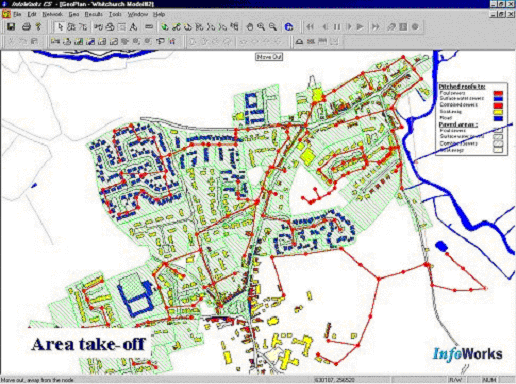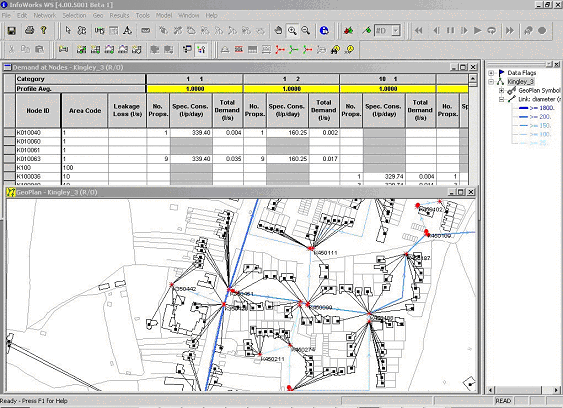|
|
|
Technical Paper November 2001 |
Abstract
Water companies in the UK recognise the important role GIS plays in the management of asset data, and the importance of integrating GIS technologies with business and operational applications such as water modeling software. This paper demonstrates with reference to the InfoWorks CS (Collection System), WS (Water Supply) and RS (River System) modeling software suite how geographic data and ESRI's ArcGIS can assist in the modeling of river catchments, urban drainage and water distribution systems in the UK. The aim of this is to achieve regulatory requirements, meet financial targets, carry out design work, and improve the operational and environmental management of rivers, water distribution networks and collection systems.
This paper attempts to illustrate how and why GIS and 1-D hydraulic modeling software have formed a ‘partnership’ to assist network managers to deliver data and information to the hydraulic modeling community in the UK Water Industry.
1.0 Introduction
Numerical 1-D Hydraulic Modeling of the urban environment, water networks and rivers has played a vital role in providing the UK Water Industry with solutions for protecting the environment, meeting UK Government and European Regulations, meeting OPEX and CAPEX business targets, and improving the efficiency of Water Companies in managing their assets. In short, numerical 1-D Hydraulic Network Modeling software in the UK has been essential in meeting expected levels of service and in reducing costs.
Wallingford Software Ltd and HR Wallingford have been at the fore-front of hydraulic modeling technology and research in the UK with the development of software products for modeling waste water systems (these include HydroWorks and InfoWorks CS), water supply systems (WesNet and InfoWorks WS) and river systems (iSIS and InfoWorks RS).
The UK water industry has invested heavily in the implementation of GIS and asset databases which until recently have been under utilised by the modeling community. One of the main reasons for this is that GIS and databases have fallen short on delivering well maintained and quality controlled network data, and traditionally has not been owned by modellers. Moreover, GIS management and network modeling have been perceived as separate tasks, with the two communities regarding each other with suspicion. However, new data extraction and cleansing techniques together with better linkages between GIS and modeling software, has been instrumental in producing good quality geographic data enabling modellers to build bigger networks faster and more reliably without the need for particularly strong GIS skills.
2.0 Business Drivers for Hydraulic Modeling in the UK Water Industry
Through a combination of EU and UK Government regulation and the need to improve efficiencies in capital and operational expenditure, hydraulic modellers and hydraulic modeling software have developed a “partnership” with GIS and found an important niche in the UK Water Industry. The following section outlines why this is the case for the urban drainage, water supply and river modeling communities.
2.1 Waste Water Systems
The main drivers in the UK Water Industry that have led to the development of numerical 1-D Urban Drainage Hydraulic Modeling software products are:
- UK requirement for records to be kept of all sewers including asset information.
- Assessment of flooding during severe events.
- Assessment of spills to rivers.
- Future impact assessment (population increase).
- Design of new structures such as storage tanks, and treatment works.
- Storage utilisation assessment (real time control).
- Identifying and locating areas of high infiltration.
- Locating unidentified overflows.
- Maintenance planning (ie. what happens if part of the system is taken out of service).
Numerical modeling software and GIS have developed in parallel to provide tools to enable engineers to understand and assess the performance of the sewerage system. These tools are used to design the system to ensure compliance with environmental and financial regulations and to accommodate the changing demands placed on the networks. The focus of drainage management has changed over the years starting in the early 1990’s with the need to solve flooding problems relating to the lack of storage, development of drainage area plans in 1994, Asset Management Planning 1 (AMP 1) was concerned with flooding and rehabilitation, AMP 2 and AMP 3 were the UK government’s interpretation of the European Commission’s proposal concerning municipal wastewater treatment known as the Urban Wastewater Treatment Directive (UWWTD).
Water companies in the UK have extended considerable resources in the collation and analysis of data required for their AMP submissions, with much of the work prior to AMP3 conducted without the establishment of GIS based asset and operational databases. The coupling of GIS and Hydraulic modeling software with the incorporation of 32-bit technology has provided the tools to enable engineers to better manage and maintain network asset data, assess and monitor the performance of the network through the establishment of indicators, quantify an asset’s serviceability, determine more accurately the necessary levels of capital and operational expenditure relative to levels of service, and plan for the future.
2.2 Water Supply Network Modeling
Numerical 1-D Hydraulic Modeling of Water Supply and Distribution networks in UK Water Industry has been applied:
- As a planning tool for setting up procedures to be used in case of bursts or exceptional demands such as fire flows.
- To design pressure control schemes and District Meter Areas (DMAs). DMAs are designed with the minimum number of metered inlets consistent with supplying the required current and future demand in the area. Meters are then read to look for trends in demand and leakage levels. Pressure control is designed at DMA level to reduce excessive pressures controlling existing leakage and demand.
- To model calibration points of those areas with low pressures due to age of mains and reduced capacity, rehabilitation strategies can then be based on model results. Ideal routes for carrying out rehabilitation can also be simulated for minimum customer disruption.
- To determine if increasing demand will simulate future requirements or additions to the network.
- To locate assets not achieving the required level of service and provide options and scenarios to alleviate the problems.
- Areas where water quality may not be adequate due to age of water or lack of chlorine can be investigated and alleviation methods tested. In the event of a pollution incident the rate of spread of a substance through a network can be investigated.
- The cost of water and pumping can be applied and cost reducing strategies investigated.
3.0 Technology
This section briefly outlines the important milestones in the development of 1-D hydraulic modeling software in the UK, and introduces some of the key applications of GIS in hydraulic modeling of urban and rural areas.
3.1 Waste Water Systems
The important milestones in the development of urban drainage modeling software in the UK are presented in Table 1.
The incorporation of GIS and database technology was not possible until the introduction of InfoWorks CS, which is built around 32-bit Windows technology. InfoWorks CS provides linkages to ArcView GIS through the incorporation of MapObjects technology to enable data to be converted directly into the InfoWorks CS model database for model build purposes. Such data includes:
- Network asset data (i.e. conduits, manholes and ancillaries).
- Sub-catchments (contributing areas).
- Surface area breakdown (road/roof polygon areas) from impermeable area study for area take off calculation.
- Population data (address point).
- Rainfall profiles from Thiessen polygon analysis.
- Viewing all ESRI data types and image formats (e.g MrSID, ECW) as background mapping layers.
|
Year |
Software/Milestones |
|---|---|
|
1982 |
Mainframe WASSP |
|
1984 |
MicroWASSP |
|
1989 |
WALLRUS ( including MicroRAT & Hydrograph Method for network design) |
|
1992 |
SPIDA |
|
1993 |
MOSQITO |
|
1994 |
HydroWorks PM |
|
1995 |
HydroWorks Quality Model |
|
1998 |
InfoWorks CS |
Table 1. Significant milestones in Waste Water Modeling software in the UK
Additionally, InfoWorks CS exports network asset data and simulation results from within InfoWorks to shapefile format so that the verified and validated network model, and model results can be viewed and analysed in ArcGIS. Full thematic mapping on static and dynamic data is available in the InfoWorks product set.

Figure 1. Impermeable Area Survey for Area Take Off Analysis.
Figure 1 illustrates the application of GIS and GI data to represent the permeability of surfaces in an urban area. Impermeable area surveys are conducted to establish an understanding of the distribution of impermeable and permeable areas in catchments in order that the correct “surface type” can be assigned to features in the urban environment. This is typically carried out through a survey of the catchment, and represented digitally in a GIS using a combination of data acquired from the UK Ordnance Survey and aerial photography. The area take-off option allows you to calculate runoff surface areas and the contributing area for a sub-catchments using data imported from ArcView.
3.2 Water Supply Systems
Key technology milestones in the development of 1-D water supply network modeling are presented in Table 2.
GIS and GI data also assists modellers through the incorporation of supporting asset information (pipe condition, class, material, age etc.). It provides the functionality to assign elevation to nodes and customer points using digital elevation data, and to associate spatial information such as bursts and customer complaints with hydraulic data.
|
Year |
Software/Milestones |
|---|---|
|
1979 |
Mainframe computers – WatNet |
|
1986 |
PC Based simulators |
|
1990 |
Linked Graphics and Model data – WesNet, WatNet |
|
1992 |
MS Windows platform |
|
1996 |
Full Windows Interface |
|
1998 |
Incorporation of GIS – 32 bit-technology |
|
1998 |
All mains modeling |
|
1999 |
InfoWorks WS – GIS, database |
Table 2. Significant milestones in water supply modeling software in the UK
The InfoWorks WS software streamlines the modeling process by automating the most repetitive tasks and providing flexible links to all the source data. The functionality of modeling software has extended well beyond just simulation, examples include:
- GIS data cleanup and connectivity checking.
- Links to logger and telemetry in their own formats.
- Automatic demand allocation.
- Automatic setting of elevations.
- Look-up tables to set asset attributes (e.g. pipe diameter and roughness).

Figure 2. Demand allocation – assigning demand to nodes.
The main purpose for providing the direct link between InfoWorks WS and ESRI products is to facilitate model building and automatically allocate demand using a combination of GI data (shapefiles, ArcInfo data), Office data files (e.g. Access, Excel), text files (e.g. comma-separated variable). The tools in InfoWorks WS have been developed using MapObjects technology to enable the:
- Automatic derivation of elevations at all nodes, spatial data (e.g. bursts, complaints) and customer points using the UK Ordnance Survey Landform Panorama data set.
- Automatic allocation of demand at any node and/or pipe using geo-referenced seed point information such as address point (see Figure 2)
- Incorporation of any geo-referenced information to support the modeling process such as customer complaints and pipe bursts. These can then be allocated to the nearest main and pipes graded by structure as well as hydraulic condition.
Figure 2 illustrates the incorporation of address point data to allocate demand at nodes. The address point data was imported into InfoWorks in shapefile format, having been prepared using ArcView. A base demand is applied for unmetered customers in appropriate units (eg. litres per property per day) or for metered consumption demand can be extracted from the billing data.
Acknowledgements
The author would like to acknowledge the contribution of Mike Reeves and Tom Merrifield of Wallingford Software Ltd.
Article © Wallingford Software 2001

